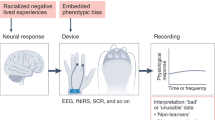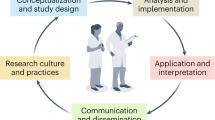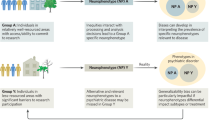Abstract
Across the brain sciences, institutions and individuals have begun to actively acknowledge and address the presence of racism, bias, and associated barriers to inclusivity within our community. However, even with these recent calls to action, limited attention has been directed to inequities in the research methods and analytic approaches we use. The very process of science, including how we recruit, the methodologies we utilize and the analyses we conduct, can have marked downstream effects on the equity and generalizability of scientific discoveries across the global population. Despite our best intentions, the use of field-standard approaches can inadvertently exclude participants from engaging in research and yield biased brain–behavior relationships. To address these pressing issues, we discuss actionable ways and important questions to move the fields of neuroscience and psychology forward in designing better studies to address the history of exclusionary practices in human brain mapping.
This is a preview of subscription content, access via your institution
Access options
Access Nature and 54 other Nature Portfolio journals
Get Nature+, our best-value online-access subscription
$32.99 / 30 days
cancel any time
Subscribe to this journal
Receive 12 print issues and online access
$259.00 per year
only $21.58 per issue
Buy this article
- Purchase on SpringerLink
- Instant access to full article PDF
Prices may be subject to local taxes which are calculated during checkout

Similar content being viewed by others
Change history
09 November 2023
A Correction to this paper has been published: https://doi.org/10.1038/s41593-023-01516-z
References
Caicedo, H. H. Surfacing anti-Black science and building antiracist teams. Nat. Biotechnol. 38, 923–925 (2020).
Gilpin, N. W. & Taffe, M. A. Toward an anti-racist approach to biomedical and neuroscience research. J. Neurosci. 41, 8669–8672 (2021).
Wheaton, L. A. Racial equity and inclusion still lacking in neuroscience meetings. Nat. Neurosci. 24, 1645–1647 (2021).
De Los Reyes, A. & Uddin, L. Q. Revising evaluation metrics for graduate admissions and faculty advancement to dismantle privilege. Nat. Neurosci. 24, 755–758 (2021).
Henrich, J., Heine, S. J. & Norenzayan, A. Most people are not WEIRD. Nature 466, 29–29 (2010).
Halpin, Z. T. Scientific objectivity and the concept of ‘the other’. Women’s Stud. Intl Forum 12, 285–294 (1989).
Allchin, D. Pseudohistory and pseudoscience. Sci. Educ. 13, 179–195 (2004).
Challis, D. The Archaeology of Race: the Eugenic Ideas of Francis Galton and Flinders Petrie (A&C Black, 2013).
Selden, S. Transforming better babies into fitter families: archival resources and the history of the American eugenics movement, 1908–1930. Proc. Am. Philos. Soc. 149, 199–225 (2005).
Ma, C. & Schapira, M. An Analysis of Richard J. Herrnstein and Charles Murray’s: The Bell Curve: Intelligence and Class Structure in American Life (Macat Library, 2017).
Girolamo, T., Parker, T. C. & Eigsti, I. M. Incorporating dis/ability studies and critical race theory to combat systematic exclusion of Black, Indigenous, and People of Color in clinical neuroscience. Front Neurosci. 8, 988092 (2022).
US Food & Drug Administration. Diversity plans to improve enrollment of participants from underrepresented racial and ethnic populations in clinical trials; draft guidance for industry; availability. https://www.fda.gov/regulatory-information/search-fda-guidance-documents/diversity-plans-improve-enrollment-participants-underrepresented-racial-and-ethnic-populations (2022).
US Department of Health and Human Services. NIH RCDC Inclusion Statistics Report (National Institutes of Health, 2018–2021).
Miller, K. L. et al. Multimodal population brain imaging in the UK Biobank prospective epidemiological study. Nat. Neurosci. 19, 1523–1536 (2016).
Sudlow, C. et al. UK Biobank: an open access resource for identifying the causes of a wide range of complex diseases of middle and old age. PLoS Med. 12, e1001779 (2015).
Li, J. et al. Cross-ethnicity/race generalization failure of behavioral prediction from resting-state functional connectivity. Sci. Adv. 8, eabj1812 (2022).
Van Essen, D. C. et al. The WU-Minn Human Connectome Project: an overview. Neuroimage 80, 62–79 (2013).
Fry, A. et al. Comparison of sociodemographic and health-related characteristics of UK Biobank participants with those of the general population. Am. J. Epidemiol. 186, 1026–1034 (2017).
Henrich, J., Heine, S. J. & Norenzayan, A. The weirdest people in the world? Behav. Brain Sci. 33, 61–83 (2010).
Woitowich, N. C., Beery, A. & Woodruff, T. Meta-research: a 10-year follow-up study of sex inclusion in the biological sciences. Elife 9, e56344 (2020).
Littlejohns, T. J. et al. The UK Biobank imaging enhancement of 100,000 participants: rationale, data collection, management and future directions. Nat. Commun. 11, 2624 (2020).
George, S., Duran, N. & Norris, K. A systematic review of barriers and facilitators to minority research participation among African Americans, Latinos, Asian Americans, and Pacific Islanders. Am. J. Public Health 104, e16–e31 (2014).
Habibi, A., Sarkissian, A. D., Gomez, M. & Ilari, B. Developmental brain research with participants from underprivileged communities: strategies for recruitment, participation and retention. Mind Brain Educ. 9, 179–186 (2015).
Hodge, F. S. No meaningful apology for American Indian unethical research abuses. Ethics Behav. 22, 431–444 (2012).
Scharff, D. P. et al. More than Tuskegee: understanding mistrust about research participation. J. Health Care Poor Underserved 21, 879–897 (2010).
Gamble, V. N. Under the shadow of Tuskegee: African Americans and healthcare. Am. J. Public Health 87, 1773–1778 (1997).
Brandt, A. M. Racism and research: the case of the Tuskegee Syphilis Study. Hastings Cent. Rep. 8, 21–29 (1978).
Khabele, D., Holcomb, K., Connors, N. K. & Bradley, L. A perspective on James Marion Sims, MD, and anti-black racism in obstetrics and gynecology. J. Minim. Invasive Gynecol. 28, 153–155 (2021).
Rodriguez, M. A. & García, R. First, do no harm: the US sexually transmitted disease experiments in Guatemala. Am. J. Public Health 103, 2122–2126 (2013).
Reverby, S. M. Ethical failures and history lessons: the US Public Health Service research studies in Tuskegee and Guatemala. Public Health Rev. 34, 189206 (2012).
Skloot, R. The Immortal Life of Henrietta Lacks (Broadway Paperbacks, 2017).
Corbie-Smith, G., Thomas, S. B. & George, D. M. M. S. Distrust, race, and research. Arch. Intern. Med. 162, 2458–2463 (2002).
Momplaisir, F. et al. Understanding drivers of coronavirus disease 2019 vaccine hesitancy among blacks. Clin. Infect. Dis. 73, 1784–1789 (2021).
Hussain‐Gambles, M., Atkin, K. & Leese, B. Why ethnic minority groups are under‐represented in clinical trials: a review of the literature. Health Soc. Care Community 12, 382–388 (2004).
Dula, A. African American suspicion of the healthcare system is justified: what do we do about it? Camb. Q. Healthc. Ethics 3, 347–357 (1994).
Brandon, D. T., Isaac, L. A. & LaVeist, T. A. The legacy of Tuskegee and trust in medical care: is Tuskegee responsible for race differences in mistrust of medical care? J. Natl Med. Assoc. 97, 951 (2005).
Jaiswal, J. & Halkitis, P. N. Towards a more inclusive and dynamic understanding of medical mistrust informed by science. Behav. Med. 45, 79–85 (2019).
Mehra, R. et al. Black pregnant women ‘Get the Most Judgment’: a qualitative study of the experiences of Black women at the intersection of race, gender, and pregnancy. Women’s Health Issues 30, 484–492 (2020).
Razai, M. S., Osama, T., McKechnie, D. G. & Majeed, A. COVID-19 vaccine hesitancy among ethnic minority groups. BMJ 372, n513 (2021).
Choy, T., Baker, E. & Stavropoulos, K. Systemic racism in EEG research: considerations and potential solutions. Affec. Sci. https://doi.org/10.1007/s42761-021-00050-0 (2021).
Etienne, A. et al. Novel electrodes for reliable EEG recordings on coarse and curly hair. 42nd Annual Intl Conf. of the IEEE Engineering in Medicine & Biology Society (EMBC) 6151–6154 (IEEE, 2020).
Webb, E. K., Etter, J. A. & Kwasa, J. A. Addressing racial and phenotypic bias in human neuroscience methods. Nat. Neurosci. 25, 410–414 (2022).
Parker, T. C. & Ricard, J. A. Structural racism in neuroimaging: perspectives and solutions. Lancet Psychiatry 9, e22 (2022).
Sjoding, M. W., Dickson, R. P., Iwashyna, T. J., Gay, S. E. & Valley, T. S. Racial bias in pulse oximetry measurement. N. Engl. J. Med. 383, 2477–2478 (2020).
Bradford, D. E. et al. Whose signals are we amplifying? Towards a more equitable clinical psychophysiology. Preprint at PsyArXiv https://doi.org/10.31234/osf.io/c2naf (2022).
Thompson, C. Black women, beauty, and hair as a matter of being. Women’s Studies 38, 831–856 (2009).
Kapoor, R., Wang, J., Zavala, A. M., Truong, A. T. & Truong, D.-T. Metallic microbeads for hair extensions: hidden dangers for magnetic resonance imaging. Radiol. Case Rep. 17, 3274–3276 (2022).
Duncan, I. C. The ‘aura’ sign: an unusual cultural variant affecting MR imaging. AJR Am. J. Roentgenol. 177, 1487 (2001).
McKinstry, R. C. & Jarrett, D. Y. Magnetic susceptibility artifacts on MRI: a hairy situation. Am. J. Roentgenol. 182, 532 (2004).
Wang, X., Thayer, J. F., Treiber, F. & Snieder, H. Ethnic differences and heritability of heart rate variability in African and European American youth. Am. J. Cardiol. 96, 1166–1172 (2005).
Celedón, J. C. et al. Respiratory health equality in the United States. The American Thoracic Society perspective. Ann. Am. Thorac. Soc. 11, 473–479 (2014).
Whittaker, J. R., Driver, I. D., Venzi, M., Bright, M. G. & Murphy, K. Cerebral autoregulation evidenced by synchronized low frequency oscillations in blood pressure and resting-state fMRI. Front. Neurosci. 13, 433 (2019).
Van Harten, B., de Leeuw, F. -E., Weinstein, H. C., Scheltens, P. & Biessels, G. J. Brain imaging in patients with diabetes: a systematic review. Diabetes Care 29, 2539–2548 (2006).
Kalaria, R. N. Diabetes, microvascular pathology and Alzheimer disease. Nat. Rev. Neurol. 5, 305–306 (2009).
Black, J. L. & Macinko, J. Neighborhoods and obesity. Nutr. Rev. 66, 2–20 (2008).
Bennett, A., Parto, P. & Krim, S. R. Hypertension and ethnicity. Curr. Opin. Cardiol. 31, 381–386 (2016).
Murphy, K., Birn, R. M. & Bandettini, P. A. Resting-state fMRI confounds and cleanup. Neuroimage 80, 349–359 (2013).
Calvin, R. et al. Racism and cardiovascular disease in African Americans. Am. J. Med. Sci. 325, 315–331 (2003).
Hinkelbein, J., Koehler, H., Genzwuerker, H. V. & Fiedler, F. Artificial acrylic finger nails may alter pulse oximetry measurement. Resuscitation 74, 75–82 (2007).
Stolier, R. M. & Freeman, J. B. Neural pattern similarity reveals the inherent intersection of social categories. Nat. Neurosci. 19, 795–797 (2016).
Sturge-Apple, M. L. et al. Vagal tone and children’s delay of gratification: differential sensitivity in resource-poor and resource-rich environments. Psychol. Sci. 27, 885–893 (2016).
Miller, G. E., White, S. F., Chen, E. & Nusslock, R. Association of inflammatory activity with larger neural responses to threat and reward among children living in poverty. Am. J. Psychiatry 178, 313–320 (2021).
White, S. F., Nusslock, R. & Miller, G. E. Low socioeconomic status is associated with a greater neural response to both rewards and losses. J. Cogn. Neurosci. 34, 1939–1951 (2022).
Handwerker, D. A., Ollinger, J. M. & D’Esposito, M. Variation of BOLD hemodynamic responses across subjects and brain regions and their effects on statistical analyses. NeuroImage 21, 1639–1651 (2004).
Greene, A. S. et al. Brain–phenotype models fail for individuals who defy sample stereotypes. Nature 609, 109–118 (2022).
Will, T. R. et al. Problems and progress regarding sex bias and omission in neuroscience research. eNeuro 4, ENEURO.0278-17.2017 (2017).
Goldfarb, M. G. & Brown, D. R. Diversifying participation: the rarity of reporting racial demographics in neuroimaging research. NeuroImage 254, 119122 (2022).
Dhamala, E., Jamison, K. W., Jaywant, A. & Kuceyeski, A. Shared functional connections within and between cortical networks predict cognitive abilities in adult males and females. Hum. Brain Mapp. 43, 1087–1102 (2022).
Dhamala, E. et al. Proportional intracranial volume correction differentially biases behavioral predictions across neuroanatomical features and populations. NeuroImage 260, 119485 (2022).
Coley, R. Y., Johnson, E., Simon, G. E., Cruz, M. & Shortreed, S. M. Racial/ethnic disparities in the performance of prediction models for death by suicide after mental health visits. JAMA Psychiatry 78, 726–734 (2021).
Singleton, K. S., Tesfaye, R., Dominguez, E. N. & Dukes, A. J. An open letter to past, current and future mentors of Black neuroscientists. Nat. Rev. Neurosci. 22, 71–72 (2021).
Subbaraman, N. How #BlackInTheIvory put a spotlight on racism in academia. Nature 582, 327–328 (2020).
Murray, D.-S. et al. Black in neuro, beyond one week. J. Neurosci. 41, 2314–2317 (2021).
Liu, S. et al. Chinese Color Nest Project: an accelerated longitudinal brain-mind cohort. Dev. Cogn. Neurosci. 52, 101020 (2021).
National Science Foundation. Doctorate Recipients from US Universities: 2020. https://ncses.nsf.gov/pubs/nsf22300/report (2020).
Blignaut, P. & Wium, D. Eye-tracking data quality as affected by ethnicity and experimental design. Behav. Res. Methods 46, 67–80 (2014).
United States Census Bureau: American Community Survey, S1601 Language Spoken at Home. https://data.census.gov/cedsci/table?q=United%20States%20Spanish%20speaking&g=0100000US (2020).
Flores, A. 2015, Hispanic Population in the United States Statistical Portrait. Pew Research Center’s Hispanic Trends Project. https://www.pewresearch.org/hispanic/2017/09/18/2015-statistical-information-on-hispanics-in-united-states/ (2020).
Ramírez-Castañeda, V. Disadvantages in preparing and publishing scientific papers caused by the dominance of the English language in science: the case of Colombian researchers in biological sciences. PLoS ONE 15, e0238372 (2020).
Blasi, D. E., Henrich, J., Adamou, E., Kemmerer, D. & Majid, A. Over-reliance on English hinders cognitive science. Trends Cogn. Sci. 14, S1364–S6613 (2022).
Krueger, P. M. & Reither, E. N. Mind the gap: race/ethnic and socioeconomic disparities in obesity. Curr. Diab. Rep. 15, 95 (2015).
Ocloo, J. & Matthews, R. From tokenism to empowerment: progressing patient and public involvement in healthcare improvement. BMJ Qual. Saf. 25, 626–632 (2016).
Ginde, A. A., Foianini, A., Renner, D. M., Valley, M. & Camargo, C. A. Jr The challenge of CT and MRI imaging of obese individuals who present to the emergency department: a national survey. Obesity 16, 2549–2551 (2008).
Roberts, S. O., Bareket-Shavit, C., Dollins, F. A., Goldie, P. D. & Mortenson, E. Racial inequality in psychological research: Trends of the past and recommendations for the future. Perspect. Psychol. Sci. 15, 1295–1309 (2020).
DeJesus, J. M., Callanan, M. A., Solis, G. & Gelman, S. A. Generic language in scientific communication. Proc. Natl Acad. Sci. USA 116, 18370–18377 (2019).
Dotson, V. M. & Duarte, A. The importance of diversity in cognitive neuroscience. Ann. N. Y. Acad. Sci. 1464, 181–191 (2020).
Conley, M. I. et al. The racially diverse affective expression (RADIATE) face stimulus set. Psychiatry Res. 270, 1059–1067 (2018).
Nichols, T. E. et al. Best practices in data analysis and sharing in neuroimaging using MRI. Nat. Neurosci. 20, 299–303 (2017).
Harnett, N. G. & Ressler, K. J. Structural racism as a proximal cause for race-related differences in psychiatric disorders. Am. J. Psychiatry 178 579–581 (2021).
Harrell, C. J. P. et al. Multiple pathways linking racism to health outcomes. Du Bois Rev. 8, 143–157 (2011).
Acknowledgements
This work was supported by the National Institute of Mental Health (R01MH120080 and R01MH123245 to A.J.H.) and the Kavli Institute for Neuroscience at Yale University (Postdoctoral Fellowship for Academic Diversity to E.D.). J.K. was supported by NIH K00NS115331 and the Burroughs Wellcome Fund.
Author information
Authors and Affiliations
Corresponding authors
Ethics declarations
Competing interests
The authors declare no competing interests.
Peer review
Peer review information
Nature Neuroscience thanks Deanna Barch, Karla Miller, and the other, anonymous, reviewer(s) for their contribution to the peer review of this work.
Additional information
Publisher’s note Springer Nature remains neutral with regard to jurisdictional claims in published maps and institutional affiliations.
Rights and permissions
About this article
Cite this article
Ricard, J.A., Parker, T.C., Dhamala, E. et al. Confronting racially exclusionary practices in the acquisition and analyses of neuroimaging data. Nat Neurosci 26, 4–11 (2023). https://doi.org/10.1038/s41593-022-01218-y
Received:
Accepted:
Published:
Issue date:
DOI: https://doi.org/10.1038/s41593-022-01218-y
This article is cited by
-
Achieving equitable recruitment through inclusive protocol design: lessons learned from the ILANA study
Trials (2025)
-
The history and future of resting-state functional magnetic resonance imaging
Nature (2025)
-
Quality over quantity: powering neuroimaging samples in psychiatry
Neuropsychopharmacology (2025)
-
Considering the interconnected nature of social identities in neuroimaging research
Nature Neuroscience (2025)
-
Psychiatric neuroimaging designs for individualised, cohort, and population studies
Neuropsychopharmacology (2025)



